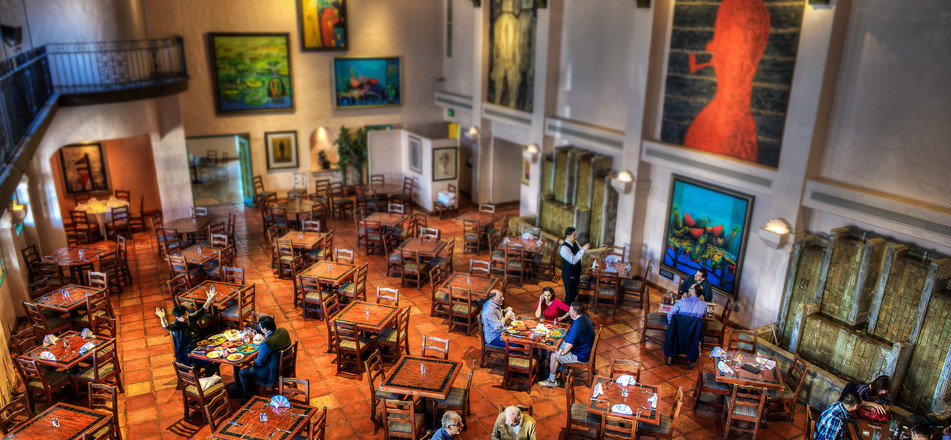TELACU's corporate headquarters, pictured above, is located in the vicinity of TELACU Industrial Park. (https://lh6.googleusercontent.com)
NOTABLE CAMPAIGNS
Throughout its existence, TELACU pursued a variety of projects that promoted economic growth in East Los Angeles. Although the organization mostly focused on commercial and residential construction during the 70s, it ventured into restaurant and institutional development in its later years. Its deviation from conventional projects demonstrates TELACU’s gradual expansion as an umbrella organization.
The Nueva Maravilla Redevelopment Project (The Barrio Housing Plan): 1972-74
|
For its first major redevelopment project, TELACU targeted Maravilla, an area at the heart of East Los Angeles full of dilapidated buildings and homes. To address the neighborhood’s deteriorated physical conditions, TELACU developed a plan to replace old housing structures with renovated ones. Because most residents in Maravilla despised urban redevelopment, TELACU deployed multiple political campaigns to win over their approval. It aligned with well-respected Eastside groups such as the Euclid Foundation and Cleland Housing to develop community support for the project. The organization also allied with local gangs, offering employment opportunities during the demolition and construction processes in exchange for a non-violent, graffiti-free area. By enabling the community to have a strong voice in the project, TELACU succeeded in creating a complex that sustained East Los Angeles residents for generations to come.
|
TELACU Industrial Park: 1976-78
|
The closure of B.F. Goodrich’s automobile plant site left over 2,300 East Los Angeles workers facing unemployment. To counter these losses, TELACU utilized both federal and coalition support to accrue funding for the TELACU Industrial Park project. Collaborating with the Ford Foundation, a local philanthropic organization, TELACU secured a $5 million loan for the purchase of the site. From the Economic Development Administration, it acquired $3.7 million for demolition purposes and site improvements. Such collaboration with both the federal government and local organizations allowed TELACU to not only transform the site into an industrial complex, but also attract employers and investments to the community. Due to the project's success, TELACU continues to create commercial and industrial centers that promote job growth in the Eastside area today.
|
Tamayo Restaurant: 1984-86
To save a Spanish colonial landmark from demolition, TELACU transformed the historic building into the Tamayo Restaurant. Although a departure from TELACU’s conventional projects, the restaurant promoted much economic growth in East Los Angeles. By hiring construction workers, contractors, restaurant managers, and waiters for various aspects of the project, TELACU created over 100 blue-collar service jobs for Eastside residents. It also attracted expanding companies and small businesses into the area. Yet, the Tamayo Restaurant campaign not only encompassed business development, but also cultural preservation and beautification as well. In addition to incorporating Oaxacan culture in its food, the restaurant decorated the dining interior with Rufino Tamayo's (an Oaxacan artist) work. This combination of culture, history, and economics reinforces TELACU's goal to promote holistic community development and self-sufficiency in East Los Angeles.
Leuzinger High School: 2010-11
|
Because Leuzinger High School faced overcrowding issues, TELACU developed a plan to incorporate an additional two-story classroom inside the institution. Through its partnership with the Overcrowded Relief Grant (ORG), TELACU selected a PreFast building design that ensured the timely development of the project. It also hired a private consultant to review grant requirements and maximize funding sources. By enlisting both public and private services, TELACU provided new facilities that mitigated overcrowding at Leuzinger High School. |
This campaign evolution ultimately reflects TELACU’s decreasing political activism over the years. During its early foundations, TELACU promoted community growth by seeking political support from well-established Eastside organizations and local gang coalitions. It also worked with the federal government to secure funding for redevelopment projects. Following the 1982 Scandal, however; the organization deemphasized political involvement and began focusing its efforts on economic development. For the Tamayo Restaurant campaign, TELACU enlisted Rufino Tamayo to promote Oaxacan culture in a for-profit setting. Similarly, it hired a consultant to ensure the success of the Leuzinger High School project. As a result of this shift from political to economic self-determination, TELACU progressed into the institution it is today.





